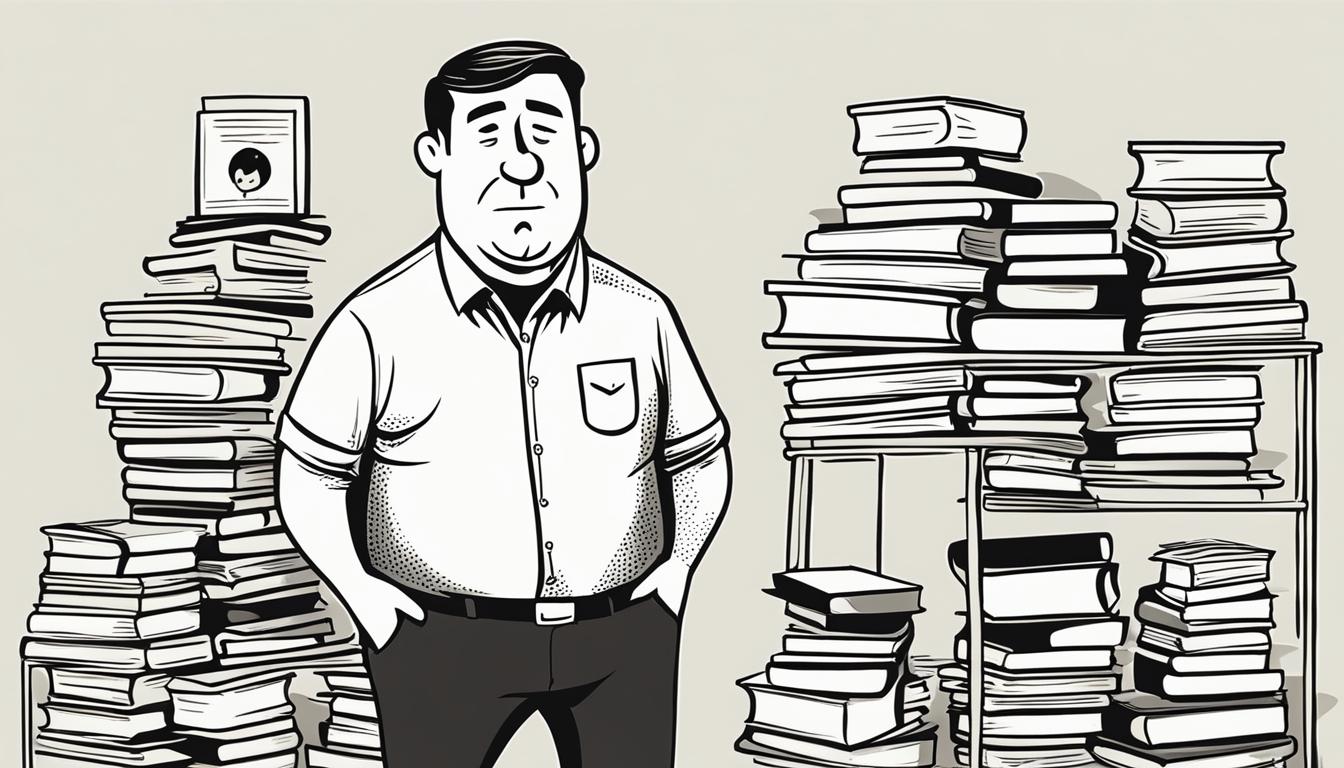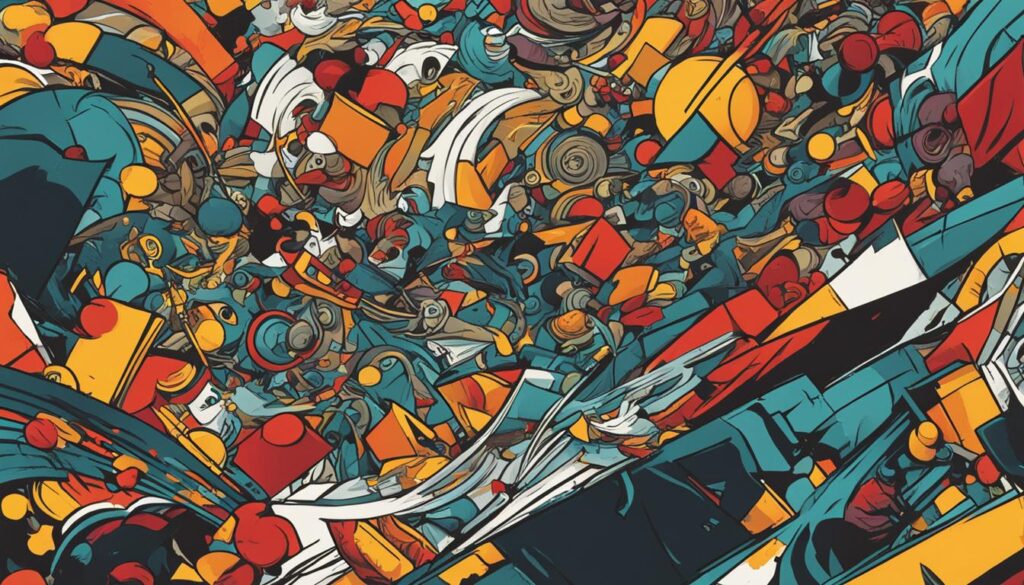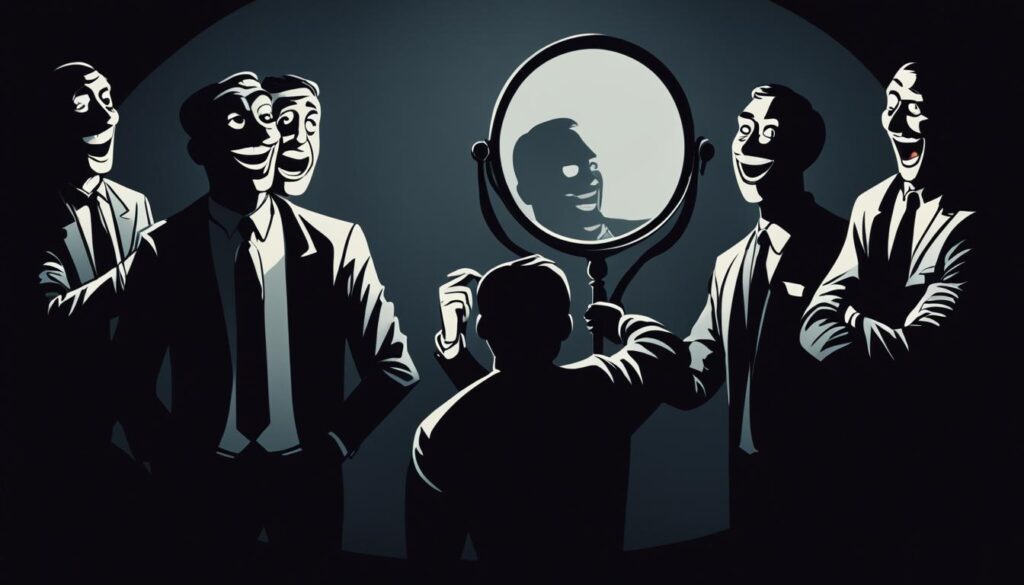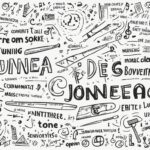I am intrigued by the enigmatic nature of individuals who possess a mocking personality. These are the individuals who constantly find amusement in ridiculing others, using derogatory humor and habitual teasing as their preferred form of communication. They are the sarcastic individuals who seem to have an unyielding need to mock and make fun of people.
This continuous mocking, this incessant laughter at the expense of others, is both fascinating and perplexing. What compels them to persistently engage in such behavior? What lies beneath their incessant need to belittle and jest at the expense of those around them?
As I explore the depths of this mocking behavior, I will delve into the psychological condition known as katagelasticism, the origins of this peculiar term, and the research conducted to better understand its complexities. We will also explore the fine line between playful mockery and harmful behavior, and the role of rapport in the acceptance of mocking. Moreover, I will shed light on the dark side of making fun of others, the psychological reasons that drive individuals to engage in mocking behavior, and the ethical erosion that occurs in positions of power.
Join me as we embark on a journey to unravel the mysteries of the mocking personality and discover the ways in which it impacts our lives and relationships.
Understanding Katagelasticism: The Psychological Condition of Excessive Mocking
I am captivated by the intriguing phenomenon of katagelasticism, a unique psychological condition that revolves around the excessive enjoyment of mocking others. Individuals with this condition actively seek opportunities to laugh at others, often resorting to mean-spirited jokes to fulfill their insatiable desire.
The consequences of katagelasticism can be far-reaching, particularly when it comes to forming and maintaining relationships. The habit of incessantly mocking others can create difficulty in establishing acquaintances and lead to strained and difficult relationships. The harm inflicted on those who become targets of such mockery is not to be underestimated. The relentless mocking not only causes emotional discomfort but also hampers social interactions, leaving lasting scars that are hard to heal.
This psychological condition is like a double-edged sword, with its excessive enjoyment masked behind the disguise of harmful humor. It is crucial to delve into the complexities of katagelasticism, exploring its origins, impact, and potential ways of addressing this challenging aspect of human behavior.
Let us embark on a profound journey to unravel the mysteries of katagelasticism, diving deep into the psyche of those who find pleasure in mocking others, and seeking a path towards understanding and empathy.
The Origins of Katagelasticism
Have you ever wondered where the term “katagelasticism” originated from? Well, let me take you back to its roots. This fascinating term was coined by Christian F. Hempelmann and Sean Harrigan, two brilliant minds who delved into the depths of human behavior. They drew inspiration from the Ancient Greek language, specifically the word “katagelastēs,” meaning “mocker.”
This clever term, katagelasticism, was carefully crafted to capture the essence of excessive enjoyment in mocking others. It encapsulates the unique psychological phenomenon of individuals who find immense pleasure in making fun of those around them. By coining this term, Hempelmann and Harrigan provided us with a powerful tool to study and understand this intricate aspect of human behavior.
When examining the origin of katagelasticism, we discover the rich history and influence of the Ancient Greek civilization. The Greeks were renowned for their philosophical inquiries and linguistic prowess. Their language served as a foundation for numerous terms and concepts that continue to shape our understanding of the human psyche.
Now, let’s take a moment to appreciate the beauty and depth of the Ancient Greek language through the lens of katagelasticism. In understanding the origin of this term, we gain valuable insights into the complex interplay between language, culture, and human behavior.
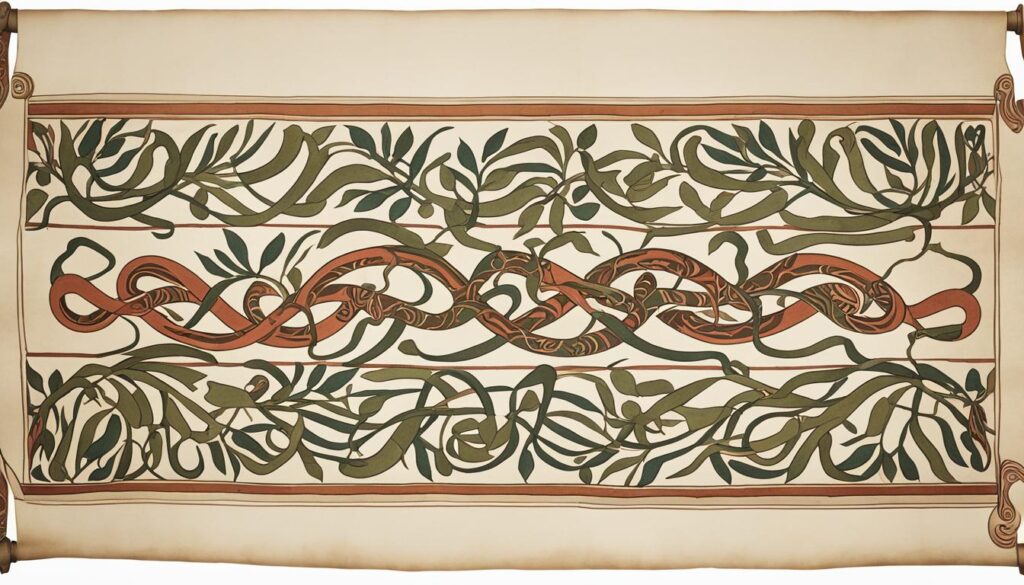
As we delve further into the realm of katagelasticism, we unlock a profound understanding of the mocker within us. Through the meticulous research of Hempelmann and Harrigan, we can shed light on the motivations, emotions, and dynamics that drive individuals with a propensity for mockery. By examining this phenomenon, we embark on a journey that allows us to explore the depths of human psychology, paving the way for empathy, comprehension, and growth.
Exploring Ancient Greek Wisdom
“In the realm of katagelasticism, we find echoes of Ancient Greek wisdom, where the power of words and laughter intertwined to shape the human experience.”
The Ancient Greeks understood the immense power of words, recognizing their ability to evoke laughter, provoke thought, and forge connections. They believed that humor could serve as a powerful tool for self-expression, social commentary, and bonding. From playwrights such as Aristophanes to philosophers like Plato, humor played a significant role in their works, resonating with audiences throughout the centuries.
In the centuries that followed, the concept of mockery evolved, taking on multifaceted dimensions in different societies and cultures. Katagelasticism emerged as a term that encapsulated the essence of this behavior, providing us with a lens through which to examine the dynamics of mockery today.
| Term | Origin | Meaning |
|---|---|---|
| katagelasticism | Ancient Greek | To mock excessively |
| katagelastēs | Ancient Greek | Mocker |
| laughter | Ancient Greek | Expression of joy |
| humor | Ancient Greek | Ability to perceive the amusing or absurd |
As we reflect on the origins of katagelasticism, let us appreciate the intricate tapestry of human behavior and the languages that allow us to convey its nuances. In our exploration of mocking personalities, the roots of katagelasticism provide us with invaluable insight and a pathway towards deeper understanding.
Research on Katagelasticism
In 2009, researchers embarked on a journey to delve deeper into the enigmatic world of katagelasticism, accompanied by their investigations into gelotophobia and gelotophilia. This trio of psychological phenomena has provided invaluable insights into the complex dynamics of human humor and the intricate interplay between the fear and enjoyment of being laughed at.
One of the tools developed to measure these psychological traits is the PhoPhiKat-45 questionnaire. Using this instrument, researchers explored the depths of individuals’ fears and pleasures when it comes to being the target of laughter. The results have been illuminating, shedding light on the multifaceted aspects of katagelasticism.
Interestingly, studies have revealed that individuals cannot simultaneously experience both fear and enjoyment when being laughed at. It is this dichotomous relationship that characterizes the intricate nature of katagelasticism. While fear and enjoyment may seem mutually exclusive, there is a positive relationship between gelotophilia, the enjoyment of being laughed at, and katagelasticism.
These findings challenge our preconceived notions about the complexities of humor and the human experience. They invite us to explore the depths of our own laughter and examine the ways in which our emotions intertwine with the act of joking and mocking others.
“Laughter is a universal language that transcends cultural barriers and connects us through the shared experience of humor and mirth.” – Researcher
Katagelasticism: A Journey of Self-Discovery
The research journey into katagelasticism has allowed us to venture into uncharted territories of the human psyche, exploring the ways in which laughter can both unite and divide us. It has provided deep insights into the complexities of our relationships and the influence of humor on our interactions.
Through rigorous scientific inquiry and the development of innovative tools, we have unraveled the intricate web of katagelasticism and illuminated its profound impact on our lives. It is a journey of self-discovery, an exploration of our capacity for laughter, and a testament to the human experience.
The PhoPhiKat-45 Questionnaire
| Phenomenon | Description |
|---|---|
| Katagelasticism | The excessive enjoyment of mocking others |
| Gelotophobia | The fear of being laughed at |
| Gelotophilia | The enjoyment of being laughed at |
Unraveling the Complexities of Katagelasticism
As researchers continue their exploration of katagelasticism, further studies are underway to unlock its complexities and gain a deeper understanding of its psychological underpinnings. By delving into the intricacies of this phenomenon, we aim to shed light on the intricacies of human humor, the dynamics of mockery, and the profound effects they have on our well-being.
Join us as we embark on this intellectual journey, unraveling the enigma of katagelasticism and paving the way for a deeper understanding of laughter, ridicule, and the fascinating landscape of human psychology.
Roasting: Playful Mockery or Harmful Behavior?
Roasting is an art, a delicate dance of words where making fun of others takes center stage. It is a form of friendly teasing that has the power to forge strong bonds through shared laughter and witty banter. Like a warm flame, roasting can bring people together, lightening the mood and creating a sense of camaraderie.
However, it is essential to tread carefully on the thin line between playful mockery and harmful behavior. While roasting done right can be a lighthearted exchange, it is important to recognize the potential for it to cross into the realm of bullying. The impact of roasting can vary, and what may seem like harmless banter to one person could deeply wound another’s self-esteem.
When roasting becomes a means to belittle or degrade others, it loses its playful essence and transforms into a damaging act. The intention behind the words shifts from bonding through mockery to inflicting pain and humiliation. It is crucial to be mindful of the effect our words have on others, understanding that everyone has different levels of tolerance and vulnerability.
Self-esteem issues can arise when individuals become the targets of hurtful roasting. Continuous mocking can chip away at a person’s confidence, leaving them questioning their own worth. The line between friendly teasing and harmful bullying blurs, leaving those at the receiving end feeling isolated and emotionally wounded.
“The scars left by harmful roasting can be invisible, but their impact can be profound. It is important to recognize the weight our words carry and the potential harm they can inflict.”
— Blaise Pascal
However, it is important not to dismiss roasting entirely, as it can exist in a healthy and mutually enjoyable space. The key lies in approaching it with sensitivity and respect, making sure that all parties involved are comfortable and willing participants. Genuine bonds can be formed through playful mockery when it is based on mutual understanding and trust.
Roasting done right can create an atmosphere where individuals feel safe and embraced, unafraid of being the target of laughter. It can be an opportunity for self-reflection, allowing us to laugh at ourselves and our quirks, fostering self-acceptance and growth.
It is essential to recognize the boundaries of roasting and navigate them with care. By promoting empathy, kindness, and awareness of the impact our words have on others, we can transform roasting into a source of joy and connection, rather than pain and isolation.
Let us remember that roasting is a dance, and like any dance, it requires grace, sensitivity, and the willingness to step back when it becomes harmful. Only then can it truly bring people together, creating bonds that withstand the test of time.
Playful Mockery vs. Harmful Behavior
| Playful Mockery | Harmful Behavior |
|---|---|
| Based on mutual understanding and consent | Inflicts pain and humiliation |
| Strengthens relationships through shared laughter | Leads to isolation and emotional wounds |
| Fosters self-acceptance and growth | Diminishes self-esteem and self-worth |
| Promotes empathy and kindness | Causes harm and emotional distress |
The Role of Rapport in Making Fun of Others
Rapport, a gentle dance of connection, plays a vital role in the intricate art of teasing in a playful way. It sets the stage for lighthearted mockery, allowing individuals to engage in banter with a sense of acceptance and shared amusement. When rapport exists between people, the lines of teasing blur into a harmonious give-and-take, where laughter weaves bonds of camaraderie.
In the realm of friendships, families, and close-knit communities, teasing becomes a vehicle for affectionate jabs and inside jokes, a language that celebrates familiarity and deep understanding. This lighthearted mockery, born out of rapport, is infused with warmth, creating an atmosphere of shared laughter and genuine connection.
“Teasing is the secret language of close relationships. It’s a dance we engage in, a delightful interplay that strengthens our bond and brings joy to our interactions.”
However, the absence of rapport can transform playful teasing into a minefield of hurt feelings and aggressive reactions. When directed toward someone who lacks familiarity or comfort with the teasing dynamic, even the most well-intentioned mockery can ignite defensive responses. Without the foundation of rapport, teasing risks becoming a weapon of verbal aggression, inflicting wounds rather than fostering connection.
So, let us cherish the role of rapport in our interactions. Let us cultivate strong connections, embrace shared laughter, and engage in playful teasing that brings joy and closeness. Through rapport, we unlock the power of acceptance, transforming mocking into a delightful dance of camaraderie.
The Dark Side of Making Fun of Others
Making fun of others can be a double-edged sword. While it can provide a temporary moment of amusement, it also has a dark side that should not be overlooked. When making fun of others crosses the line into bullying, it can cause significant harm and damage to individuals.
Bullying, in any form, can have lasting negative effects on the mental and emotional well-being of the person being targeted. Continuous mockery without establishing camaraderie or bonding can create an environment of hostility and isolation, leading to a lack of trust and healthy social interactions.
Mockery without bonding is like a hollow laughter, empty of compassion and camaraderie.
This harmful aspect of making fun of others highlights the importance of empathy and consideration in our interactions. It reminds us to be mindful of the impact our words and actions can have on others, and to strive for genuine connections based on respect and understanding.
“In the dark depths of mockery lies the absence of true camaraderie, where laughter becomes a weapon instead of a bond.”
The Destructive Power of Bullying
Bullying has far-reaching consequences, impacting not only the immediate targets but also the social fabric of communities. It perpetuates a cycle of pain and diminishes the sense of belonging among individuals. Bullying erodes self-esteem, promotes feelings of fear and powerlessness, and can lead to long-term psychological issues.
“In the shadows of mockery lie the scars of those who have been torn down and shattered, their spirits bruised by relentless torment.”
Let us abandon the path of harm and instead choose the road of understanding and compassion, forging bonds that empower and uplift.”
To create a harmonious and inclusive society, we must reject the darkness of making fun of others and embrace the light of empathy and kindness. By fostering an environment where camaraderie thrives and mockery is replaced with support, we can build stronger connections and promote the well-being of all.
Psychological Reasons Behind Mocking Others
Insecurity, discomfort with differences, learned behavior, projection, need for attention, better than average effect, and contempt towards weakness are all psychological reasons that drive individuals to mock others. These factors provide insight into the motivations behind this behavior and help to shed light on the underlying psychological processes at play.
Mocking others can often stem from feelings of insecurity. By making fun of someone else, individuals attempt to shift attention away from their own perceived flaws and weaknesses, seeking validation and a sense of superiority.
Additionally, discomfort with differences can contribute to mocking behavior. When faced with individuals who possess qualities or characteristics unlike their own, some people may feel threatened or uncomfortable. Mocking becomes a way to cope with this discomfort and establish a sense of conformity or superiority.
Learned behavior also plays a significant role in mocking others. Individuals may have grown up in environments where ridicule and sarcasm were prevalent, leading them to adopt these behaviors as a means of communication and social interaction.
“Mocking is often a projection of our own insecurities onto others. By belittling them, we temporarily alleviate our own feelings of inadequacy.”
Projection, a defense mechanism in psychology, is another psychological reason behind mocking others. By projecting their own flaws and insecurities onto others, individuals can distance themselves from these aspects of their personality, temporarily boosting their self-esteem.
The need for attention is another driving force behind mocking behavior. By making fun of someone, individuals seek the attention and validation of others. This need to be in the spotlight can stem from deeper feelings of inadequacy or a desire to be seen as funny and entertaining.
Furthermore, the better than average effect, also known as illusory superiority, can contribute to mocking behavior. Individuals may believe they are superior to others in certain aspects, leading them to mock those they perceive as weaker or lesser than themselves.
Contempt towards weakness is yet another psychological reason behind mocking. Some individuals view vulnerability or weaknesses in others as inferior traits and therefore feel the need to mock and belittle them.
Understanding these psychological reasons behind mocking others can help foster empathy and compassion, leading to more thoughtful and respectful interactions with others.
Ethical Erosion and Mocking Others
While positions of power and authority come with great responsibility, they can also be breeding grounds for ethical erosion. Those in authority often find themselves mocking subordinates, justifying their mockery as a means of reinforcing their superiority and maintaining their position of dominance.
There is a deep-rooted fear of losing their perceived superiority, which drives individuals to engage in mocking behavior to establish and assert their power. This fear stems from the belief that any hint of weakness or moral inferiority could undermine their authority, leading them to resort to mocking others as a defense mechanism.
However, this behavior raises ethical concerns as it erodes the very foundations of respect and fairness. Mocking others based on their perceived weaknesses or inferiorities not only perpetuates a toxic environment but also reflects a lack of empathy and compassion. It undermines the principles of equality and undermines the values that should guide those in positions of power.
“In my experience, it is not uncommon to witness authority figures resorting to mocking their subordinates as a means of asserting their dominance. This behavior is a clear indication of ethical erosion that contaminates the workplace culture.” – Jane Anderson
In order to preserve a healthy and respectful work environment, it is crucial to address the issue of ethical erosion and confront the underlying factors driving this behavior. By promoting a culture of inclusivity, empathy, and collaboration, organizations can challenge the fear-based mentality that fuels the need to mock others for validation.
Leaders should lead by example, fostering an environment where diversity is celebrated and differences are valued. Encouraging open and honest communication, while setting clear expectations and boundaries, can help create a culture in which mocking behavior is not tolerated.
By addressing the root causes of mocking behavior and promoting a more humane approach to leadership, we can work towards a society that values respect, empathy, and equality.
Dealing with Mocking Behavior
In order to effectively deal with mocking behavior, it is crucial to employ effective communication and assertiveness. By openly expressing your thoughts and feelings, you can address the issue head-on and establish clear boundaries. Surrounding yourself with a support system of trusted individuals can provide guidance and assistance in navigating difficult situations.
Furthermore, it is important to recognize and address any underlying issues that may be driving the mocking behavior. Insecurities or a need for attention can sometimes manifest as mocking others. By addressing these underlying issues, you can work towards resolving the root cause of the behavior.
Remember, setting boundaries and seeking support are essential steps in dealing with mocking behavior. Embracing open and honest communication, along with assertiveness, empowers you to protect yourself and address the behavior in a constructive manner.
| Techniques for Dealing with Mocking Behavior | Effectiveness |
|---|---|
| Open and honest communication | Highly effective in addressing the issue and establishing boundaries. |
| Assertiveness | Empowers individuals to protect themselves and respond to mocking behavior confidently. |
| Seeking support | Provides guidance and assistance in navigating difficult situations. |
| Addressing underlying issues | Resolves the root cause of the mocking behavior by addressing insecurities and the need for attention. |
Humor Without Putting Others Down
In the world of comedy, there is a way to bring laughter without resorting to putting others down. Seinfeld’s unique style of humor serves as a prime example of this approach. Instead of targeting individuals, Seinfeld focuses on concepts, unveiling the humor hidden in everyday situations and peculiarities. This allows for an engaging form of comedy that avoids personal attacks, making it enjoyable for a wider audience.
By shifting the spotlight from people to the quirks of ordinary circumstances and objects, Seinfeld’s style opens up new avenues of humor. It invites us to laugh at the absurdity and idiosyncrasies of life itself, without demeaning or ridiculing others. This unique perspective taps into the universal experiences we all share, bringing humor that is relatable and inclusive.
Choosing humor without putting others down not only showcases a more compassionate approach but also creates an atmosphere of unity and joy. It encourages us to find laughter in the mundane, to appreciate the unexpected, and to embrace the lighthearted side of life. In a world where personal attacks can divide, humor that focuses on concepts can bring us together, uniting us in laughter and celebration.
Source Links
- https://en.wikipedia.org/wiki/Katagelasticism
- https://medium.com/@armanitalks/the-psychology-of-making-fun-of-others-3b09cc0e3718
- https://www.aconsciousrethink.com/20563/why-people-make-fun-of-others/

